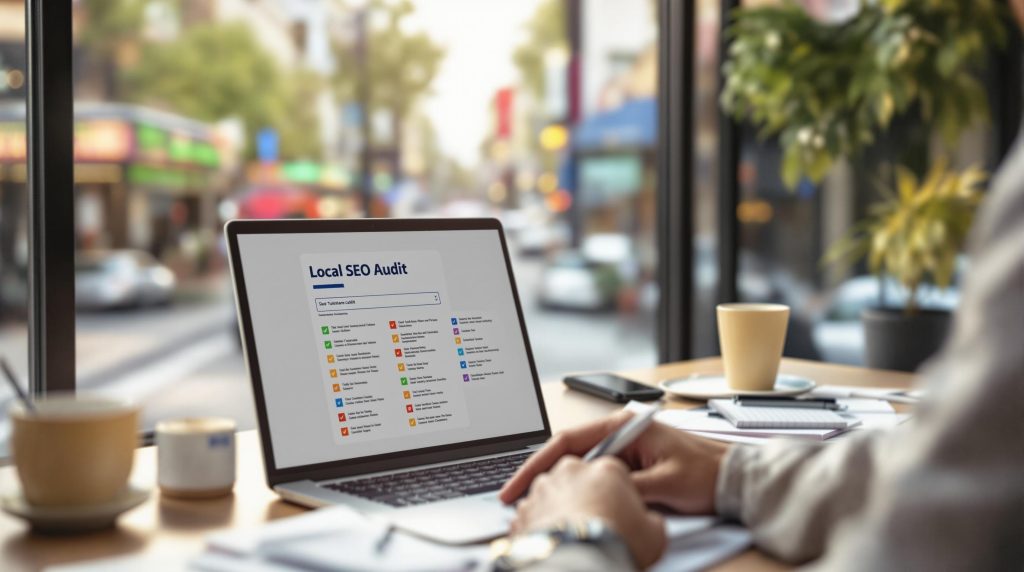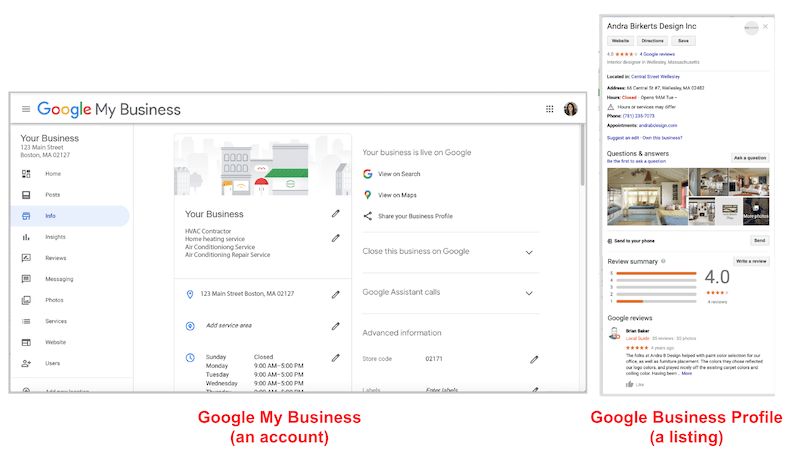Local SEO Audit & Strategy: How To Performs Audits for Local Sites

Last Updated on 30 September 2025 by Dorian Menard
Want more customers to find your business online? Start with a local SEO audit. This guide walks you through optimising your local search presence to drive traffic and boost sales. Here’s what you’ll learn:
- Why local SEO matters: 46% of Google searches are local, and 88% of smartphone users visit or call a store within 24 hours.
- Key audit steps: Check your Google Business Profile, website, local citations, and reviews.
- Tools to use: Google Analytics, Search Console, Local Falcon, and citation management platforms.
- Set SMART goals: Examples include improving rankings, traffic, conversions, and reviews.
- Track progress: Use tools to measure local rankings, traffic, and customer engagement.
Quick Overview:
- Google Business Profile: Keep your info accurate and engaging.
- Website SEO: Improve speed, mobile-friendliness, and local content.
- Citations: Ensure consistent Name, Address, and Phone (NAP) details.
- Reviews: Manage and respond to customer feedback.
- Tracking: Monitor rankings, traffic, and conversions.
Pro Tip: Local SEO takes time – expect results in 4–6 months with consistent effort.
Ready to dive in? Let’s start optimising your local SEO strategy.
Complete Local SEO Audit Checklist 2025
Audit Preparation Steps
Before diving into your local SEO audit, make sure you have the right tools in place and clear objectives defined. This will help you effectively assess everything from your Google Business Profile to business listings.
Tools You’ll Need
To carry out a local SEO audit, you’ll need these tools:
Core Audit Tools:
- Google Business Profile Manager: Manage and optimise your business listing.
- Google Analytics 4: Track website traffic and user behavior.
- Google Search Console: Monitor search performance and fix technical issues.
- Local Falcon: Automate rank tracking and analyse competitors.
- Citation Management Tools: Ensure your business listing information is consistent across platforms.
Key Metrics to Track:
- Organic local traffic
- Local pack rankings for target keywords
- Conversion rates by location
- Google Business Profile insights (e.g., calls, direction requests, clicks)
- Review ratings and sentiment across platforms
Defining Your Goals
To align your Perth SEO efforts with your business goals, follow these steps:
1. Establish Baseline Metrics
Start by recording your current performance in these areas:
- Rankings for priority keywords
- Monthly organic traffic from local searches
- Conversion rates from local visitors
- Number and quality of customer reviews
- Accuracy and consistency of citations
2. Set SMART Goals
Define specific, measurable targets that tie directly to your business outcomes. For instance:
| Goal Type | Example Target | Timeframe |
|---|---|---|
| Rankings | Reach top 3 local pack positions for 5 main keywords | 6 months |
| Traffic | Boost local organic traffic by 50% | Q3 2025 |
| Conversions | Increase local visitor conversion rate from 2.5% to 4% | 9 months |
| Reviews | Gain 50 new Google reviews with an average rating of 4.5+ | 12 months |
3. Track Progress
Keep an eye on these metrics throughout your audit process:
- Organic search traffic
- Local pack rankings
- Volume and quality of customer reviews
- Citation accuracy
- Conversion rates from local traffic
- Engagement metrics from your Google Business Profile
Improving local SEO isn’t about quick fixes – it’s about consistent, steady progress. Regularly monitor your metrics to see what’s working and make adjustments as needed.
Once your goals and tools are in place, you’re ready to dive into the evaluation phase.
Main Local SEO Elements to Check

Google Business Profile Setup
Your Google Business Profile (GBP) plays a key role in improving local visibility. With nearly half of all Google searches focusing on local information, a well-optimised profile can make a big difference.
Profile Optimisation Checklist:
- Business Information Accuracy
Ensure these details are correct:
| Element | Best Practice | Impact |
|---|---|---|
| Business Name | Use your official name without extra keywords | Builds trust and authority |
| Address | Verify location and service areas | Helps customers locate you |
| Phone Number | Use a local number | Boosts credibility |
| Website URL | Link to your main site or location page | Improves user experience |
| Hours | Keep operating hours updated, including holidays | Avoids customer confusion |
- Visual Content Management
Add high-quality images, such as professional storefront photos, team pictures, and product shots. Businesses with great visuals see 42% more direction requests and 35% more website clicks.
- Review Management
“To maximise how often users find your business in local search results, ensure that your business information in Business Profile is accurate, complete, and engaging.” – Google Business Profile Help
Once your GBP is in top shape, turn your attention to your website to strengthen local signals further.
Website Local SEO Basics
A well-optimised website complements your GBP and helps you stand out. With 88% of consumers visiting a local business within a day of searching on their mobile device, having a strong online presence is crucial.
Key Website Optimisation Areas:
- Local Content Structure
Create content that highlights your business and clearly defines your service area.
- Technical SEO Elements
- Use local business schema markup
- Ensure your site is mobile-friendly
- Improve loading speeds
- Write location-specific meta descriptions and title tags
- Content Optimisation
Since 55% of users rely on voice search via smartphones, include natural language queries in your content, such as local FAQ pages.
Business Listings and Links
Beyond your website and GBP, consistent listings across the web help reinforce your local presence.
Citation Management Strategy:
- Directory Presence
List your business in relevant industry-specific and local directories to increase visibility. - NAP Consistency
Use tools to ensure your Name, Address, and Phone (NAP) details are uniform across all platforms.
sbb-itb-c74901f
Tracking Local SEO Results
Tracking your local SEO performance is essential to ensure you’re meeting your goals and making steady progress.
Local Search Position Tracking
Monitoring your local search rankings helps you identify opportunities and measure growth. With 70% of users clicking on Google Map Pack results, staying on top of these rankings is crucial for local business success.
Comparison of Tracking Tools:
| Tool | Key Features | Price |
|---|---|---|
| Semrush | Tracks Google search positions | $139.95/month |
| Local Falcon | Scans Google & Apple Maps | $24.99/month |
| BrightLocal | Custom rank reporting | $39/month |
| SE Ranking | Analyses local ranking distribution | $62/month |
Success Story: Stratedia, a marketing agency, boosted annual earnings by $50,000 after using Semrush Local for rank tracking and visibility management. This allowed them to improve client services and onboard more customers without compromising quality.
“Local Falcon is the original multipoint local rank tracker to monitor the coverage area strength of a Google Business Profile. The reporting is unique, powerful and easy to understand; but the data visualisations are just incredible.” – Yan Gilbert, Google Platinum Product Expert and Local SEO Consultant
Traffic and Lead Measurement
Tracking website traffic and SEO lead generation using GA4 can offer deep insights into your local SEO performance.
Key Metrics to Monitor:
- Website Traffic Lead Ratio: Aim for a conversion rate of 2-4% from visitors to leads.
- Share of Local Voice (SoLV): Measure how frequently your business appears in Map Pack results.
- Geographic Performance: Track traffic and conversions by specific locations.
Real Results: A client with 500 brick-and-mortar locations achieved a 42% increase in local search traffic in just five months by using Nightwatch to optimise zip-code-level data. In another case, a GA4-based strategy led to an 18x increase in conversion rates.
Pro Tip: Integrate Google Analytics with Google Ads to evaluate landing page quality and conversion rates for your local search campaigns.
These insights help you fine-tune your strategy and focus on areas that will drive the most impact for your local SEO efforts.
Local SEO Implementation Plan
Turn your audit findings into practical steps. With 76% of consumers visiting businesses within 24 hours of searching online, driving local traffic demands a well-structured plan.
Task Priority List
Use your audit insights to focus on tasks based on their impact and resource requirements:
| Priority Level | Tasks | Expected Timeline | Impact Level |
|---|---|---|---|
| Critical | Optimise Google Business Profile (GBP), ensure NAP (Name, Address, Phone) consistency | 2-4 weeks | Immediate visibility |
| High | Mobile optimisation, fix on-page SEO issues | 1-2 months | Noticeable ranking improvement |
| Medium | Create local content, build citations | 2-3 months | Steady progress |
| Low | Advanced technical fixes, add more directory listings | 3-4 months | Long-term benefits |
Leverage these tools to implement changes effectively:
- Citation Management: Use Bright Local or Moz Local to manage business listings.
- Review Monitoring: BrightLocal helps track and respond to reviews.
- Rank Tracking: SEMrush provides insights into ranking progress, as explained in our Semrush full review.
“You might begin seeing improvements in organic ranking and an increase in traffic for keyword topics with little competition in just a few weeks. On the other hand, moderately competitive topics might take months, while highly competitive phrases could even take one year or more!” – Search Engine Journal
Plan your tasks on a timeline to ensure steady progress.
Project Timeline
Based on your audit and task priorities, organise the work into these phases:
- Foundation Phase (Weeks 1-4)
Optimise your Google Business Profile and ensure NAP details are consistent across all platforms. - Technical Implementation (Months 2-3)
Improve website speed, mobile compatibility, and address basic on-page SEO issues. - Content Development (Months 3-4)
Develop location-specific pages and create local content that aligns with user search intent. - Citation Building (Months 4-6)
Expand your presence in relevant local directories, ensuring NAP details remain consistent.
Pro Tip: Use tools like GA4 for analysing traffic, CallRail for tracking calls, and Google Search Console to monitor search performance.
Local SEO often takes 4-6 months to yield noticeable results. Consistent effort is key to maintaining and building on these improvements.
Next Steps
Now that you’ve completed your audit, it’s time to turn those insights into actionable steps.
Audit Steps Review
To see real progress in local SEO, focus on areas that can have the biggest impact. With 66% of users relying on Google for local business information, keeping your business details accurate is a top priority.
Here are the key areas to address right away:
- Google Business Profile (GBP) Updates
Make sure your GBP is up-to-date with the latest features and accurate business details. As Samantha Ridgway, Senior SEO Manager at HawkSEM, notes:“Google continues to change and/or add elements such as the ability to link to socials or list specific products and services offered directly on a GBP profile”.
- NAP Consistency
Double-check that your Name, Address, and Phone number (NAP) are consistent across all platforms, including Apple Maps. - Technical Website Check
Since 57% of local searches happen on mobile devices, focus on improving mobile usability, schema markup, and site speed.
These steps align with earlier strategies to boost your local search presence.
Getting Started
With the audit done, take these specific actions to get moving:
- Turn On GBP Notifications
This ensures you can quickly respond to reviews and update information.“Nothing puts a bad taste in a customer’s mouth quite like going out of their way to visit a local business just for their storefront to be closed, despite online business hours saying otherwise”.
- Create Localised Content
Write content that answers common customer questions and highlights nearby landmarks. - Track Your Metrics
Use the tracking methods outlined earlier to measure your efforts. Remember, 88% of smartphone users visit stores within a week of local searches.
Regular audits are key to staying ahead. Plan to review your efforts every quarter to spot new opportunities and keep improving.